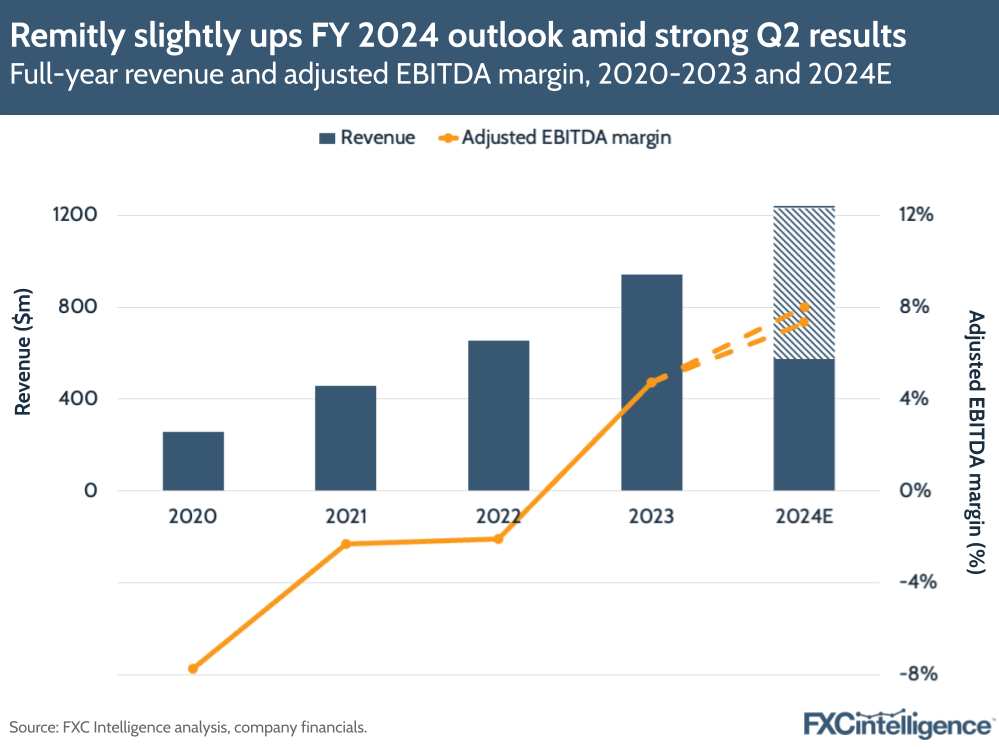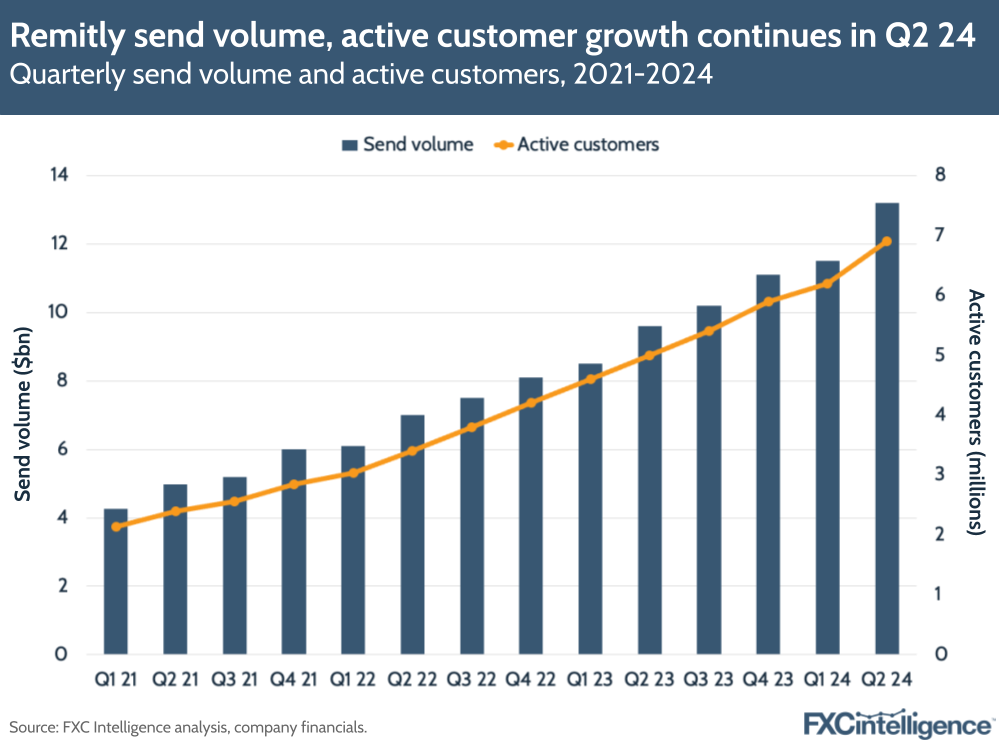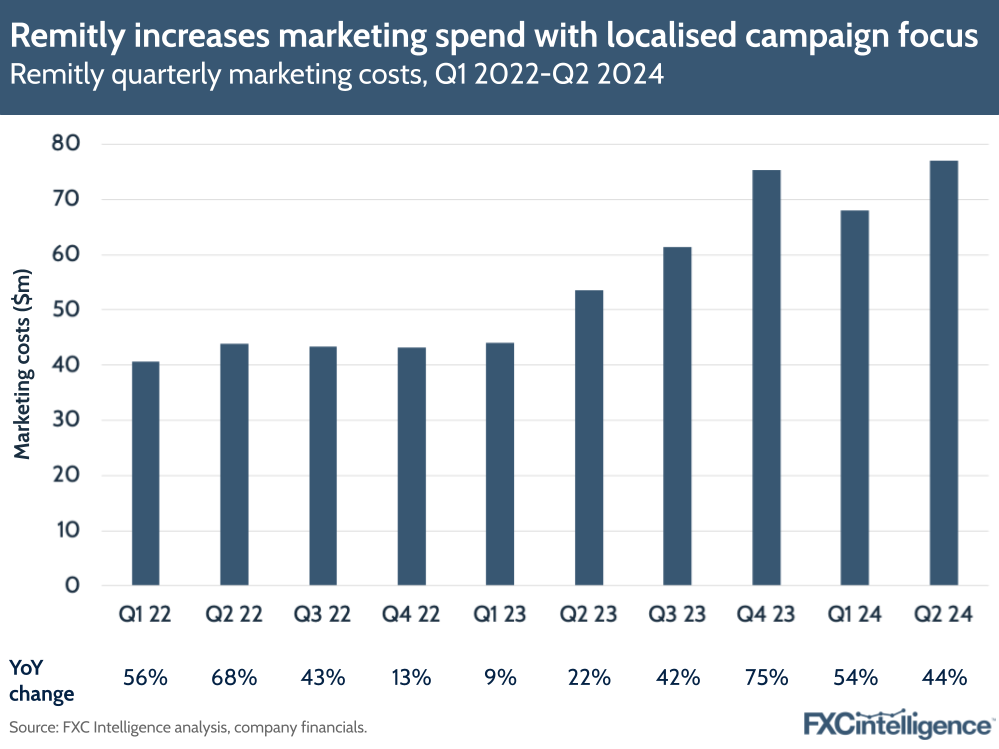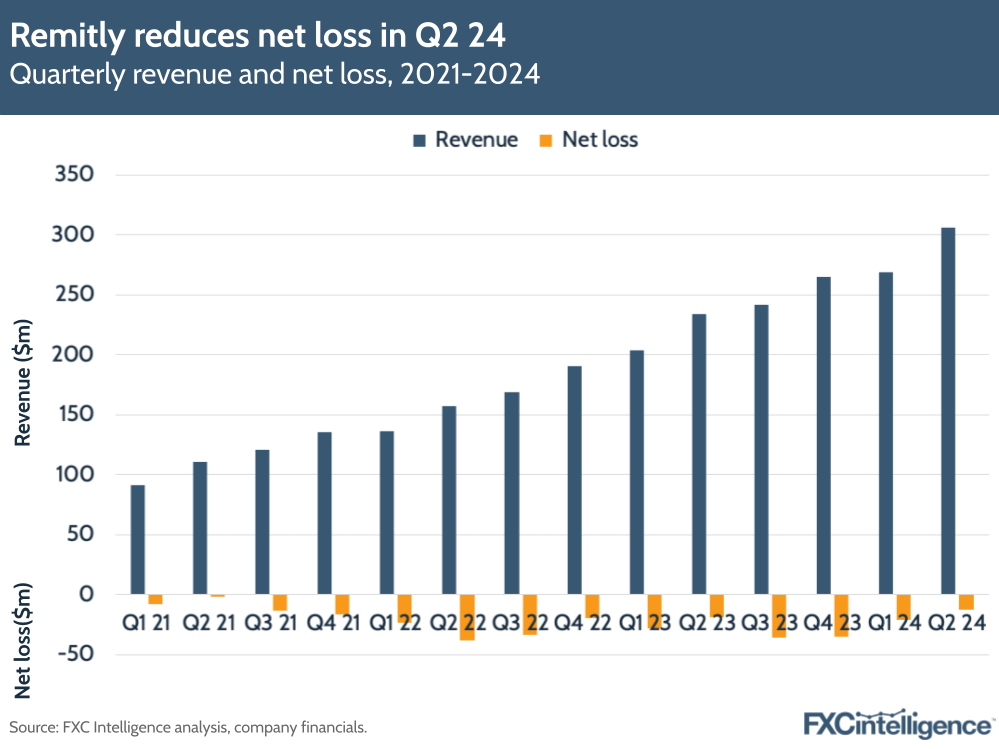Remitly’s Q2 2024 results included not just very strong results, but also details of the company’s increasing plans to broaden its reach both in terms of markets and customer types. We caught up with CEO Matt Oppenheimer to dig into the strategy.


Remitly’s Q2 2024 results saw the company beat analyst estimates and its own expectations, with a 31% YoY increase in revenue to $306m and a 23% increase in adjusted EBITDA to $25.1m. This was buoyed by strong improvements in both active customers and send volume, as well as lower losses than in many previous quarters, despite marketing costs increasing.
Central to Remitly’s approach has been efforts to refine its customer experience strategy through the use of AI as a means of first-line support. This has helped Remitly see record numbers of customers disbursed within an hour, with only one in 20 requiring a customer support agent – its lowest to-date.
Enhancing the speed, reliability and seamlessness of transactions has been one of the company’s four main focuses this quarter, alongside localised marketing, unlocking incremental customers and geographies and deepening customer relationships. This has seen Remitly not only increase its reach outside of its top three receive markets, but also diversify in terms of the customers it is reaching.
Here, the company has launched a tailored product for seafarers, and has also begun to target high send value customers, putting it increasingly in competition with non-remittance consumer money transfer players such as Wise. This approach is designed to help the company grow its share of its $1.8tn total addressable market, which it currently places at around 2.5%.
To find out more about these strategies, as well as the drivers of the company’s ongoing success, we spoke to Matt Oppenheimer, CEO of Remitly.
Drivers of Remitly’s Q2 2024 growth
Daniel Webber:
Another excellent set of results, this time leading you to up your forecasting for the year. Let’s take it from the top: what’s been driving that very strong year-over-year growth?
Matt Oppenheimer:
We’re really excited about the growth. If you put into context that we delivered $306m in revenue in Q2, up 31% year-on-year, and we’re continuing to show leverage on the expense side and bottom line, the scale and size combined with that growth rate is something we’re really excited about.
What’s driving it is ultimately our customers and our product, the predictable, resilient nature of the service we provide combined with our differentiated, trusted and reliable product.
What you see is that continued usage of our base and the fact that we have a high degree of visibility and predictability, combined with a record number of new customers at more efficient unit economics, results in continued growth while we manage the expense side, which results in additional profitability. So, excited about the quarter.
Remitly raises FY 2024 expectations on strong Q2

Remitly’s strong results saw the company achieve its second-highest adjusted EBITDA on record at 8.2% – second only to Q2 2023’s 8.7%. This allowed it to slightly improve its projections for FY 2024, with the company increasing the lower end of its revenue projection by $5m.
It is now projecting full-year revenues of $1.23bn-1.25bn and adjusted EBITDA of $90m-100m, which would give it a FY adjusted EBITDA margin of 7.3-8%. This would not only be only its second year with a positive full-year adjusted EBITDA margin, but also its strongest margin to-date.
In addition to being fuelled by strong customer growth, this was in part aided by a 260 bps drop in non-GAAP customer support expense this quarter, which occurred as a result of the company’s efforts to increase the use of AI in customer assistance.
Broadening market reach
Daniel Webber:
You’re seeing more and more customers from outside your top three receive markets of India, Mexico and the Philippines. How are you thinking about and targeting markets outside of those?
Matt Oppenheimer:
There’s lots of opportunity across the 170 countries and over 5,000 corridors that we’re in.
We’re 2.5% of the overall market, so there’s actually a large amount of room to grow in the three largest receive markets that you mentioned.
We’re seeing growth across the board, but we’re excited about everything from new markets that we’ve talked about like the UAE to regions in Latin America and Africa that, from a receive side, we’re seeing nice growth in.
There’s lots of opportunity for growth in our business and lots of geographies to do so.
Remitly grows customers, send volume

Remitly saw active customers increase 36% YoY in Q2 2024 to 6.9 million, while send volume increased by 38% to $13.2bn. This increase was aided by a rise in sending over Mother’s Day, alongside strength in the US dollar, and is attributed to the company’s improved focus on improvements to both its product and platform, particularly around tailored customer areas and improved customer service.
Crucially, the majority of these new customers in Q2 2024 were sending to markets outside Remitly’s top three – India, Mexico and the Philippines. This reflects the company’s focus on growing outside of its strongest corridors, which it says is key to improving volatility and exposure to market-specific FX and macroeconomic events.
However, the company did warn that Q3 was always seasonally weaker for the company, particularly given the lack of major holidays during this period. As a result, Remitly expects lower sequential change in active customers, however it does anticipate the rise to return in Q4 2024.
While the company saw strong growth across both active customers and send volume, average revenue per active customer did decline slightly, dropping by -5% YoY, likely as a result of the significant increase in marketing costs.
Remitly’s marketing approach
Daniel Webber:
You’re continuing to support your growth with strong marketing spend. How do you ensure that the marketing continues to deliver the numbers you want?
Matt Oppenheimer:
First is we take a really focused approach when it comes to our unit economics. A lot of companies may say that, but I think the rigour we have around what’s the customer acquisition cost [CAC], what’s the payback period and what’s the lifetime value-to-CAC on a dollar-average basis is something that we have a lot of expertise and focus on.
We mentioned that our payback continues to be well below our 12-month target and if you look at what’s driving that, it’s continued retention on the lifetime value side. But to your marketing point, we’ve been focusing on both growing rapidly – hence the 31% year-on-year revenue growth – while also testing the marginal or incremental CAC and the elasticity of that customer acquisition cost.
What we’re seeing there is favourable returns and solid growth while improving our customer acquisition costs, which we’re excited about.
Remitly grows marketing spend

Remitly also continued its focus on highly localised marketing this quarter, which sees it precisely tailor its marketing efforts in key regions in order to attract specific customer types to support its wider growth strategy.
Here the company saw its marketing cost rise by 44% YoY to $77.1m; while this is not the biggest YoY increase in marketing spend the company has reported, it is the largest amount it has spent on marketing in a single quarter to-date. In non-GAAP terms, Remitly’s marketing expenses accounted for 24% of revenue in Q2 2024.
AI’s role in product and platform improvements
Daniel Webber:
You’re a business where AI is actually really helping when it comes to evolving your product and platform. Talk us through your approach there.
Matt Oppenheimer:
It is really exciting, and I think that this is exciting for a lot of businesses out there.
We’re really unlocking tangible value to the customer and to the business with our virtual AI assistant. What that enables customers to do when they contact us is to be able to resolve their issues with this virtual AI assistant. The speed of resolution, the therefore cost efficiency gains and the percentage of customers that resolve the issue without having to then be transferred to an agent – a member of our team – is really exciting.
What that enables our agents to do as well is leverage the things that they, and only they, can do and upskill them to offer those unique things that they can solve. Then for some of the more mundane tasks, use our virtual AI assistant. It’s exciting.
That helped us deliver 260 basis points improvement year-on-year in our customer support costs, despite the fact that revenue and volume grew at the rate that it did.
If you look back five years ago, it’s probably more linear in terms of our customer support costs compared to our revenue and volume growth. Now we’re getting leverage while our revenue is growing quickly.
Partially that’s because of our virtual AI assistant, but I think there’s a lot more to come there. And partially that’s because, with our scale, we’re driving down contact rates in terms of pay-in options, pay-out options and risk via our machine learning models. So lots of excitement in that space right now.
Daniel Webber:
You shared some updated numbers around speed: 90% of transactions disbursed in under an hour and over 95% performed without a customer support contact. Those are metrics that show you’re benefiting the business.
Matt Oppenheimer:
Totally, and we’re not satisfied there. But to your point, those are good numbers and they’re numbers that we can uniquely deliver with our digital-first approach and now having the scale to do so.
It was so much harder as a founder of this business five or 10 years ago to deliver those kinds of numbers; it was virtually impossible. I look at where we can go in the next three, four, five years and our product will only get better for customers and be more differentiated, which is exciting.
Remitly reduces net losses

Despite increasing its marketing spend significantly this quarter, Remitly also reported its lowest quarterly net loss since 2021 at -$12.1m. This represents a 36% YoY improvement on Q2 2023, when the company posted net losses of -$18.9m, and is significantly below Q1 2024 when the company’s net losses were -$21.1m.
While Remitly is focused on continuing such a strong run of growth, immediate profitability is not a strong focus for the company; however, reduced net losses do put the company in a more sustainable position in the long-term.
Targeting high send value customers and other differentiated customer types
Daniel Webber:
Let’s talk about two of your latest approaches to product differentiation, which are high send value customers and seafarers. High send value customers represent a good part of the total addressable market you mentioned earlier – how are you thinking about that opportunity?
Matt Oppenheimer:
It is a big opportunity. I view it not as a strategic shift, but as one additional set of customers that we can serve, and I think we’re serving them better.
We’re making improvements in how we enable customers to send additional amounts of funds with more of a risk-based system, as opposed to having something like tier limits. We’re improving the overall product for customers that send higher dollar amounts and there are specific pain points that they face that we’re getting faster at addressing.
But I put that in the context of us also serving seafarers, and I think there’s opportunities across the board.
Our technology platform now enables us to more nimbly and quickly serve different segments of customers, which is important because we’ve got to both do that and leverage all the scale that we have, which helps get leverage on the business, which helps give us the data and analytics to drive down some of the contact rates, which gives us the scale to do more pay-in and pay-out integration.
You’ve got all of that benefit with scale combined with this more agile and nimble technology platform that enables us to deliver for seafarers, for higher dollar senders. And there’s many other sets of customers that we’re doing that for as well.
Daniel Webber:
What are the types of levers you have to change to start targeting specific groups? Seafarers are a very different product focus to high-value send, so how do you cater to that?
Matt Oppenheimer:
The main levers are making sure that we have the right compliance and KYC that’s catered to that specific set of customers and the other would be pay-in methods, and making sure that it’s easy to collect funds given that there’s a wide range of ways to collect funds across the globe and with different segments of customers.
A higher dollar sender, for example, might want bank transfer as opposed to a debit card. Those would be examples, and we’re getting faster and better at that.
We’re so excited about our ability to serve multiple different sets of customers in the right customised way.
Meeting Remitly customers
Daniel Webber:
Are there any other areas that you would like to talk through today?
Matt Oppenheimer:
You know me, I will always talk about our customers if given the opportunity to.
I mentioned in the earnings call that I spent some time with some of our seafarer customers. I went on a cruise – the first time I’ve ever been on a cruise – and I was so inspired by one specific customer who has been a cruise ship worker for 20 years.
She works 16-hour days away from her family. Historically, she had to walk off the ship during her shore breaks to take physical cash and send it back home.
There were a lot of Remitly customers that I met: not just Remitly senders, but Remitly customers. It was just poignant, the impact. It’s more convenient, it’s lower cost, it’s trusted and it’s a customer base that is indicative of a lot of our customers.
But it was just very poignant in terms of the sacrifices they make, the inconvenience they used to have before using Remitly and we’re just getting started in serving those customers.
That’s what I’d end with: that’s why we’re here. That’s why we do what we do. It’s what we’re going to continue to do.
Daniel Webber:
Matt, thank you.
Matt Oppenheimer:
Thank you.
The information provided in this report is for informational purposes only, and does not constitute an offer or solicitation to sell shares or securities. None of the information presented is intended to form the basis for any investment decision, and no specific recommendations are intended. Accordingly, this work and its contents do not constitute investment advice or counsel or solicitation for investment in any security. This report and its contents should not form the basis of, or be relied on in any connection with, any contract or commitment whatsoever. FXC Group Inc. and subsidiaries including FXC Intelligence Ltd expressly disclaims any and all responsibility for any direct or consequential loss or damage of any kind whatsoever arising directly or indirectly from: (i) reliance on any information contained in this report, (ii) any error, omission or inaccuracy in any such information or (iii) any action resulting there from. This report and the data included in this report may not be used for any commercial purpose, used for comparisons by any business in the money transfer or payments space or distributed or sold to any other third parties without the expressed written permission or license granted directly by FXC Intelligence Ltd.



